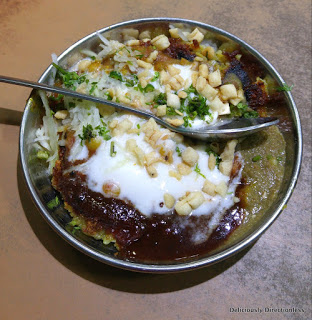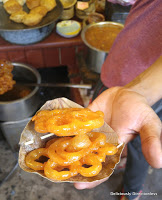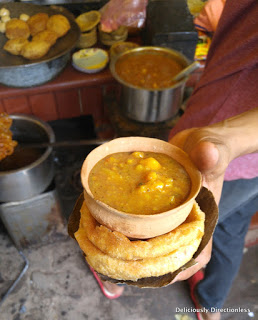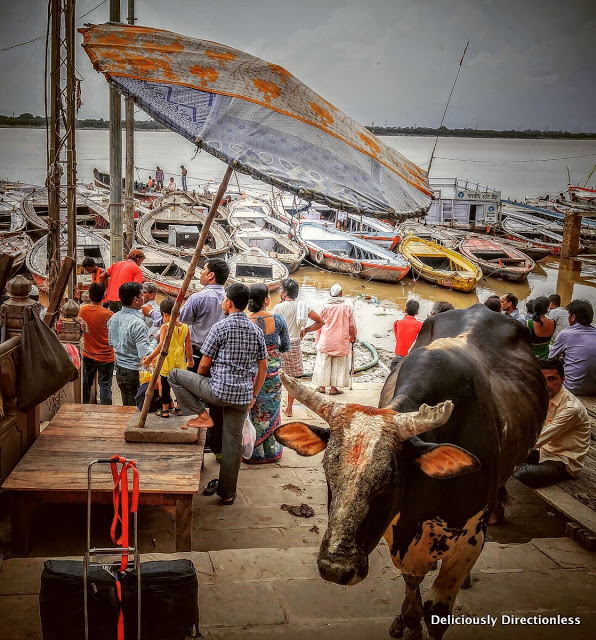
What see, do and where to stay in Varanasi
“Banaras is older than history, older than tradition, older even than legend, and looks twice as old as all of them put together”. Mark Twain’s description of Varanasi all those years ago still holds true.
My husband and I were in Varanasi at the invitation of Plush Escapes and we stayed at Suryauday Haveli at Shivala Ghat – a charming, intimate boutique hotel overlooking the mighty Ganga.
See my video of Shivala Ghat below.
The airport is at least an hour away from the city, and by the time we got to the hotel, we just wanted to rest a bit (considering we arrived from Mumbai on a 7.30 a.m. flight!). Stepping inside the haveli, it’s easy to forget all the noise and chaos of Varanasi. It’s just so peaceful!
See the sunrise on Shivala Ghat video below
Read about our experience at Suryauday Haveli, Varanasi on the Plush Escapes blog. Meanwhile, here’s my 48-hour mini-guide for Varanasi.
One of the must-do experiences at Varanasi is the evening Ganga Aarti. Unfortunately, we couldn’t witness this. Varanasi had received an unusually heavy spell of rain the week before our visit, and though it didn’t rain while we were there (and most of the flood waters had receded from the city), the ghats were still flooded and caked with mud and silt at many places. The aarti, which usually takes place on the Dashashwamedh Ghat, had shifted to the terrace of a nearby building. It still overlooked the Ganga, but it wasn’t going to be the same experience, obviously!
So we decided to skip the aarti altogether and explore the tiny by-lanes that led from Suryauday Haveli to Dashashwamedh Ghat and the city centre. There’s an entire labyrinth of alleys that leads from the hotel towards the ghat, running more or less parallel to the main Godolia Road, taking you past shops, cafes, restaurants, chaiwallahs, mini-markets, lassi wallas and the like. The bustling lanes were packed with locals shopping, tourists walking around slightly dazed, sadhus hoping to make a quick buck, dogs snarling at each other, and cows plodding by as if they owned the street (which they probably did).
 We stopped by at Bana Lassi, a colourful shop with a library of sorts at the entrance, hippie-style graffiti on its walls, and pithy slogans painted everywhere. We enquired about their specialty and the owner said that the pomegranate and coconut lassi was a hot favourite with his customers – it sounded suitably weird so obviously, the husband opted for it! I settled for the regular malai lassi. The lassis arrived in big earthen cups and were satisfyingly thick and delicious. We even polished off the pomegranate-coconut concoction.
We stopped by at Bana Lassi, a colourful shop with a library of sorts at the entrance, hippie-style graffiti on its walls, and pithy slogans painted everywhere. We enquired about their specialty and the owner said that the pomegranate and coconut lassi was a hot favourite with his customers – it sounded suitably weird so obviously, the husband opted for it! I settled for the regular malai lassi. The lassis arrived in big earthen cups and were satisfyingly thick and delicious. We even polished off the pomegranate-coconut concoction.

 Our next stop was Kashi Chaat Bhandar, a highly recommended place by several friends. We ordered the tamatar chaat, a Varanasi specialty of cooked tomatoes and potatoes, served with a thin, spicy curry and topped with salty, crunchy namakpara (deep-fried pastry bits). I loved the sweet-spicy combination of the chaat and also the subtle textural contrast of the namakpara; it sort of reminded me of the Maharashtrian dish of misal (though the flavour profile was different).
Our next stop was Kashi Chaat Bhandar, a highly recommended place by several friends. We ordered the tamatar chaat, a Varanasi specialty of cooked tomatoes and potatoes, served with a thin, spicy curry and topped with salty, crunchy namakpara (deep-fried pastry bits). I loved the sweet-spicy combination of the chaat and also the subtle textural contrast of the namakpara; it sort of reminded me of the Maharashtrian dish of misal (though the flavour profile was different).
We wanted to try the palak chaat, another local specialty of batter-fried spinach leaves served in chaat form, but it was not available. So we settled for a tikki chaat (fried potato cutlet topped with chutneys and yoghurt), and followed it up with a delicious kulfi falooda.
The next morning I set out with the hotel’s guide Sanjay who had agreed to take me for the Varanasi staple breakfast of kachori-sabzi-jalebi. But first, we decided to pay homage to the presiding deity of the city and headed to the Kashi Vishwanath Temple, one of the 12 Jyotirlingas (the holiest of Shiva temples). The temple has been in existence for centuries, but it has been destroyed and rebuilt several times. The current temple dates to 1780 and is known for its gleaming gold-plated domes. The temple complex houses five temples in all and is under a heavy security cover. Avoid taking handbags, mobile phones, cameras etc., else you will need to stow all your belongings in the government provided lockers or those at one of the numerous flower vendors around the temple.
That done we proceeded to hunt for breakfast. It was a bit past 11 a.m. so many of the kachori vendors were already sold out, but I was in search of Babu Lal Kachori Wala who apparently sets up shop every day around 10 a.m. at the entrance of Kachori Galli near the Kashi Vishwanath Temple. And he was exactly where my friend had said he would be. He was out of jalebis but seeing my crestfallen face he said that he was just about to make a new batch. Is there anything better than piping hot jalebis, just fried and dunked in sugar syrup?!

 I stood watching mesmerised as Babu Lal (I assumed) expertly piped the jalebi batter straight into the boiling oil, making the jalebis in pretty flower shapes (see video above). A few minutes of frying and the golden brown jalebis were ready to be transferred into the cauldron of sugar syrup nearby. The kachoris (puris actually, but with masalas kneaded right into the dough) had just been made as well, puffed up little beauties that Babu Lal’s assistant stuffed into a leaf bowl, ladled the potato curry-like sabzi on them and topped with the jalebis. It tasted heavenly, the sweet-spicy combination, the asafoetida laced kachori a subtle contrast to the syrupy jalebi. Such a soul-satisfying breakfast, and so cheap too! Just Rs. 36 for 4 kachoris, a bowlful of sabzi and 2 fat jalebis…
I stood watching mesmerised as Babu Lal (I assumed) expertly piped the jalebi batter straight into the boiling oil, making the jalebis in pretty flower shapes (see video above). A few minutes of frying and the golden brown jalebis were ready to be transferred into the cauldron of sugar syrup nearby. The kachoris (puris actually, but with masalas kneaded right into the dough) had just been made as well, puffed up little beauties that Babu Lal’s assistant stuffed into a leaf bowl, ladled the potato curry-like sabzi on them and topped with the jalebis. It tasted heavenly, the sweet-spicy combination, the asafoetida laced kachori a subtle contrast to the syrupy jalebi. Such a soul-satisfying breakfast, and so cheap too! Just Rs. 36 for 4 kachoris, a bowlful of sabzi and 2 fat jalebis…
I washed down this breakfast of champions with a glass of thick lassi at Raja Ramji’s Lassi Shop in Thateri Galli (this shop took a bit of hunting, but the local shop-owners helpfully pointed out the way). Raja Ramji made a fresh batch of lassi for me, ladling yoghurt and thick cream into a pot, throwing in some ice and water, sugar syrup, and a few drops of rose essence (watch the video below). He then expertly churned the lassi till it frothed and foamed, and handed me a glass of creamy, cold goodness. I pretty much waddled back to the hotel…
Later that evening I went on a different exploration of the city with Walks of Varanasi, an initiative started by the students of the venerable Benares Hindu University (BHU), which offers travellers a taste of the city.
 The organisation has a selection of walking tours (including food tours, cycling tours, and boat tours). I opted for the Heritage Walk of Lanes (Rs. 1,400 pp), a two-hour meandering walk through the lanes and by-lanes of the old city. My guide Anup regaled me with stories of the city and its spirituality, pointing out places of interest (and colourful houses with pretty designs decorating their doorstep), while we engaged in a theological discussion about our respective religious beliefs. It was two hours well spent and I’d highly recommend this tour to really get under the skin of the city; just remember to watch your step and avoid the fairly ubiquitous cow dung ‘pies’ on the streets!
The organisation has a selection of walking tours (including food tours, cycling tours, and boat tours). I opted for the Heritage Walk of Lanes (Rs. 1,400 pp), a two-hour meandering walk through the lanes and by-lanes of the old city. My guide Anup regaled me with stories of the city and its spirituality, pointing out places of interest (and colourful houses with pretty designs decorating their doorstep), while we engaged in a theological discussion about our respective religious beliefs. It was two hours well spent and I’d highly recommend this tour to really get under the skin of the city; just remember to watch your step and avoid the fairly ubiquitous cow dung ‘pies’ on the streets!
If you’re looking to eat a bit differently, I have two recommendations for you, both within 5 minutes’ walk from Suryauday Haveli.
We went to the Bread of Life Bakery for breakfast before flying out of Varanasi. The coffee sucks and the French pancakes (crepes) were strictly OK, but we had a stack of perfectly done American pancakes, complete with maple syrup and butter. They were so fluffy and light, and could easily give many Mumbai restaurants a run for their money! We ran into a French couple who raved about the cafe’s lasagne and ratatouille – we’ll take their word for it.

Our other odd experience was, wait for it, eating Japanese in Varanasi! Iba Cafe and Restaurant is owned by a Japanese expat and serves some pretty authentic Japanese meals. We tried the Chicken Gyoza (Japanese dumplings), Tori Tendon (a bowl of mirin rice topped with chicken tempura and veggies, with a side of miso soup), and the Japanese Set Meal (a mix of starters, mains, and desserts) – all the dishes were flavourful and fairly close to the real deal. The meal was accompanied by cups of San Cha Rose Tea. Many so-called Japanese restaurants in Mumbai could do with a crash course at Iba!
This is by no means a complete guide to Varanasi – we didn’t visit the BHU campus (apparently an oasis of greenery), nor did we venture to Sarnath to take in the Buddhist shrines. And of course, we will have to return to see a proper Ganga Aarti – another trip to Varanasi is definitely on the cards.
Have you visited Varanasi? What was your favourite thing to do, see or eat? Leave us a comment and let us know (and add to our to-do list for the next trip!)























You didn't visit a single weaver??
Was there over Thursday-Friday, and apparently they are closed on Fridays (which I didn't know)
Glad to know that you had great trip to one of the best spiritual place of India and City of Luminous “Varanasi”. I have been there before, and I was truly impressed with the charm and grace of the city. Varanasi is not only famous for its divine bright but also for the food, and I would like to share about some great places to eat in Varanasi. Pizzeria Vatika at Assi Ghat for fresh Juices and authentic food fire pizza and Baba Lassi.
Thanks for sharing your recommendations!
nice article everything is explained properly keep it up